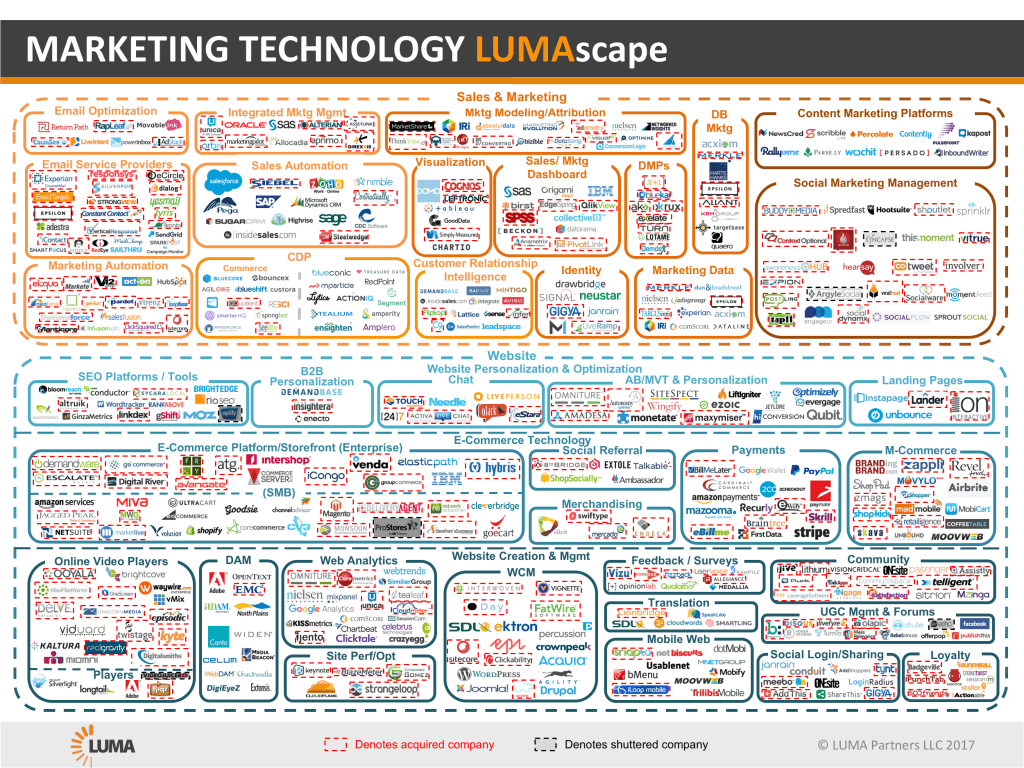Without marketing strategy, the LUMAscape is one hand clapping
Execution teams have the tech to segment and target consumers while strategists manually pull together disparate data sets to develop personas.
It’s difficult not to be awed by the LUMAscape, both in its growth rate and in the level of innovation that it represents. Consider this: in 2011, there were only 150 unique companies on the LUMAscape, in 2018 there are 7,000. And it’s not merely a matter of vendors throwing their hats into the ring to take advantage of a flush industry; these are enterprises on the cutting edge of Big Data, AI, machine-learning and programmatic technologies.
Clearly, this innovation has been a boon to marketers and publishers, and yet, to a large extent, it represents just one hand clapping, with the entire LUMAscape ecosystem focusing on marketing operations and execution. The people who are responsible for buying media have a great deal of technology and data at their disposal, but what about the marketing strategists, who are responsible for generating personas, campaign ideation and targeting? They have nothing like the level of tools enjoyed by the marketing orchestration team.
Marketing strategy is still created using old (in our field, it’s fair to consider them ancient) methodologies. Back in the 1950s, strategists relied on demographic data to build personas because it was both widely available and reliable. If women, aged 25 to 50, purchased this product from this brand, then other women with similar demographics are likely to exhibit the same behavior. The personas were beefed up with psycho-demographics, developed through consumer surveys.
And to be fair, these personas delivered good results, because there were few channels to reach consumers back then. If a family-friendly vacation brand wanted to reach every American family, it could reliably do so by purchasing a 30-second spot on Mutual of Omaha’s Wild Kingdom on Sunday evenings. Reach used to trump relevance.
The world looks nothing like that today. We now live in a world where there are infinite ways to reach a consumer, thanks to the explosion of digital and social, and the myriad ways for people to consume content. Yet the strategy is still dominantly based on demographics and psycho-demographics.
With both sides of marketing operating in vastly different worlds, a gap between strategy and execution is inevitable. When the media-buying team receives a marketing brief the first thing they need to do is interpret the marketing goals. With just segments based on generic demographic and behavioral data, they must translate the personas into actual segments they can target in the complex execution ecosystem. Not too long ago, I spoke with the head of marketing for a large brand. He told me his team received a 150-page report on their ideal “buyer personas” that didn’t match any syndicated audience segments, so they had to try to “translate” these personals into targetable segments based on their media buying platforms.
Is it any surprise that digital campaigns — designed to reach and engage consumers with ads that are groundbreaking in their creativity – fall short of expectations? The process is broken, and it is neither the strategy team’s nor the execution team’s fault. The problem is that the machine learning and artificial intelligence is being applied to marketing execution but doesn’t address the needs of the marketing strategist. Marketing strategists need the same level of audience segmentation and insights that are available to the marketing execution team.
Until the strategy side catches up, the inherent power of the execution ecosystem, represented by the LUMAscape, will be under-utilized. It will remain the equivalent of one hand clapping.
Contributing authors are invited to create content for MarTech and are chosen for their expertise and contribution to the search community. Our contributors work under the oversight of the editorial staff and contributions are checked for quality and relevance to our readers. MarTech is owned by Semrush. Contributor was not asked to make any direct or indirect mentions of Semrush. The opinions they express are their own.
Related stories
New on MarTech
